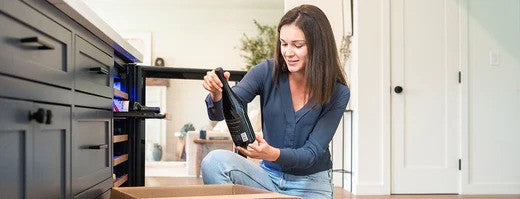
A Guide to Wine Storage Temperatures
Proper wine storage is vital in making or breaking wine aging potential.
In fact, temperature might be the most essential part of wine storage.
As a fellow wine enthusiast, you likely have the perfect place for keeping your precious bottles of gold and ruby.
Here's everything you need to know about the best temperatures for storing wine.

Best Places to Store Wine
Ideally, a wine cellar or wine storage fridge will be the best for your wine's long-term storage.
Don't look to your regular kitchen fridge for this. It may be good enough for meats and cheeses, but it's far too cold for wine storage.
Other factors to consider when storing wine include light exposure, humidity, and bottle position.
Dark, damp spaces with proper humidity will provide the best storage temperatures.
Ideally, humidity should be between 60-68% to keep the cork from drying out. Laying a bottle of wine on its side will also help keep the cork moist and give the wine oxygen.
Regarding light and sun exposure, keeping stored wine away from the sun is best, so a space with no windows will be best. UV rays will break down the wine, causing it to age too early and possibly spoil.

Wine Storage Temperature Chart
The best-storing temperature overall for short-term and long-term wine storage is around 55 degrees Fahrenheit (or 13 degrees Celsius). This keeps the wine at an even temperature and prevents it from freezing or overheating, which can break down valuable properties.
A good rule of thumb is to keep your stored wine nice and cool at this temperature, as anything below 25 degrees Fahrenheit (minus 4 degrees Celcius) or above 68 degrees Fahrenheit (20 degrees Celcius) will damage the wine.
But if you're looking for the best temperature to suit a specific type of wine, let's consider the differences between red, white, and sparkling wine storage needs.
Red Wine Storage Temperature
Depending on the red wine, you can store it in slightly warmer temperatures. Full-bodied red wines like Cabernet Sauvignon, Malbec, or Zinfandels are best kept at around 63 degrees Fahrenheit or 17 degrees Celcius.
In comparison, darker full-bodied reds like Shiraz can take a bit more heat at around 66 degrees Fahrenheit or 19 degrees Celcius.
Red wines with a higher concentration of tannins can generally be kept in warmer temperatures.
However, light and medium reds like Pinot Noir and Merlot should be kept close to the 55-degree rule and no hotter than 60 degrees.
If you have light blush wines like Rosé, storing them at slightly cooler temperatures, between 50 and 55 degrees Fahrenheit (10-13 degrees Celcius), is best.
Now that we've addressed the proper temperatures to store red wine, let's look at whites!

White Wine Storage Temperature
Because they are lighter than most reds, white wines thrive in even cooler temperatures.
White wines should be stored between 45 and 55 degrees Fahrenheit (7-13 degrees Celcius), depending on their residual sugar levels. This will help to maintain their more delicate fruit and floral aromas.
Dry wines like Chardonnay can be stored at around 53 degrees Fahrenheit, while other dry wines like Pinot Gris and Sauvignon Blanc should be stored at temperatures no more than 47 degrees Fahrenheit.
For sweeter whites like Moscato or Pinot Grigio, keep temperatures lower between 42 and 45 degrees Fahrenheit.
But what about the slightly more delicate sparkling wines?
Sparkling Wine Storage Temperature
Even lighter than the previous two categories, sparkling wines should be kept in the coldest storage conditions at no more than 40-45 degrees Fahrenheit.
Champagne should be kept at a slightly chilly 44 degrees, while Riesling deserves a bit more ice at just 42 degrees.
Be sure to take extra care with these delicate wines, as they won't last anywhere near room temperature.
Now let's look at what to do with your wine after storing it.
Best Wine Serving Temperature
After your wine has had a chance to hang out in a dark, properly humidified cellar or wine fridge for a while, it's time to serve it to your guests (or enjoy it yourself).
You'll want to serve red wine slightly chilled below room temperature, between 58-65 degrees Fahrenheit.
Remember that red wines may need time to oxidize in a decanter to balance out their more robust flavors.
White wines should be allowed to warm up for serving at around 45-55 degrees.
Sparkling wines will taste best at a super icy 38-45 degrees.
These temperatures will help bring out the best in your wine.

Temperature Matters
When it comes to serving and storing, the temperature of your wine can enhance or diminish the tasting experience.
A wine fridge might be a good investment if you don't have a temperature-controlled cellar tucked away from the sun's harsh UV rays.
They're easy to manage and friendly to tighter spaces, making them a great choice if you want to store wine in your home.
Shop high-quality wines at low prices today by visiting the Macy's Wine collection.
Check out the Macy's Insiders Blog for more wine-caring tips and other fun industry facts.